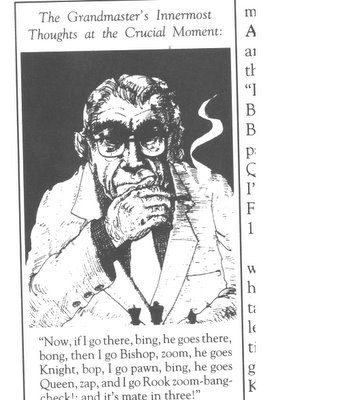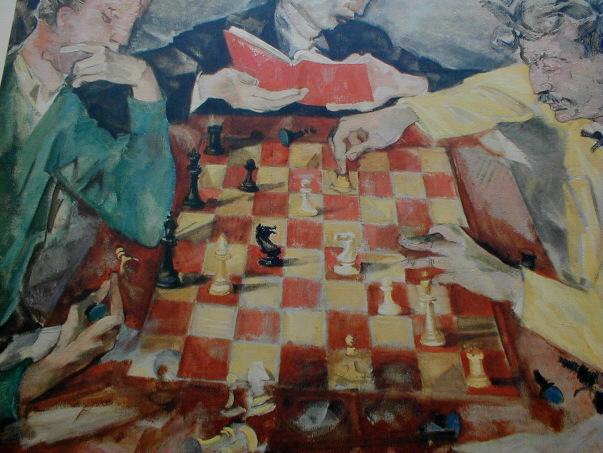The GM's Innermost thoughts

The GM in the Cartoon is probably the ideal quickly seeing a positions possiblities from his experiences (pattern recognition). I am very interested in some of the specifics of what exactly builds pattern recognition and the interrelationship between calculation,tactical pattern recognition and tactical pattern learning.The following is a brain dump about these artifical classifications.
Pattern Recognition I believe is a number of different elements such as
1)Recognizing a position in it's entirety
2)Recognizing a elements within a position (ie:queen and king on the same file,rank,diagonal thus making it subseptible to a Pin)
3)Recognition of Relationships within a position (opponents knight on f6 guards h7 square which if were to occupy it with my supported queen would be checkmate)
4)Recognition of the nature of the position(stalemate, pawn promotion,limited mobility of a piece,etc)
4)Recognition of things one would like to do and what prevents it.
5)In most cases association with prior Tactical Knowledge
6)recognition of specific strategic goals inherent in the position
7)Association of positions,elements with past play and study
8)Pattern Recognition involves a quick seeing
I define Calculation as the process used to solve a tactical problem not instantly solved by pattern recognition.
1)asking oneself questions about the initial position
2)visualizing sequences of moves
3)rearranging move order
4)asking questions about structure and relationship of pieces.
5)testing ideas and possible counterplay by opponent
6)in exchanges, there is a weighing element(counting,I sacked a rook and a bishop for a queen was it worth it? )
6)working with the position till pattern recognition takes over
7)Calculation involves a searching for a pattern and manipulating this pattern as opposed to an instantaneous seeing.
8)With repetition of problem solving, repeated calculation may bond the Pattern with the Pattern Knowledge
Building Tactical Knowledge or Pattern Learning-This is the base of which every thing else is supported>it is the chunks as Blue Devil Knight calls it
1)knowing how a piece move (it seems trivial but we often "calculate" how a knight moves as opposed to instantly seeing the squares it can move to)
2)knowing a mating position(there are complex mating postion where I still have to calculate if all escape squares are covered)
3)knowledge of the geometry of the chessboard diagonals, which squares are dark or light,knowledge of where g4 is on the board etc
4)Understanding of pattern characteristics( a pins piece has lost it's ability to recapture on a square it defends, the concept of removal of the guard)
5)Building the tactic series pattern (legal mate,smothered mate, and the 1001 other pattterns )
6)Much of chess is the ability to simplfy the position on the board to a known pattern be it checkmate, winning endgame, pawn promotion, stalemate. Tactical Knowledge is knowing this patterns.
7)Pattern Recognition may be viewed as accessing this knowledge with minimal use of calculation and perhaps bypassing this completely
So my belief is that Ct-art Training in the early stages for a under 1400 player first turns to Calculation and a little pattern recognition. Due to the errors there is an opportunity to build tactical knowledge.
With the middle circles there is a little less calculation with some increasing pattern recognition and more effective tactical knowledge building due to the prior exposure.
With the latter circles there is minimal calculation(or much faster/effective calculation), more pattern buiding and very fast pattern recognition.
The Seven Circles in a way is a attempt to streamline or Automate(?) the process of selecting a move over the board like the GM in the cartoon. However if he had really
pattern recognized it would be more like....................take take take checkmate where's the food!
*******************************
tues 494
wed 512
thur


2 Comments:
At 4:38 AM, Temposchlucker said…
Temposchlucker said…
It's a good overview. Certain patterns give you an advantage above others while other patterns are so common that everybody knows them. It's almost impossible to gain advantage with common patterns. It are the special patterns that decide the game.
A form of hard to see pattern is the "invisible" pattern. For instance in the simplest form the rule of the square of a passed pawn.
If you see such invisible square you have an advantage over who doesn't.
Take for instance my last game http://www.chesslog.de/users/temposchlucker/?game=536
after move 15. Rxd1 the black queen has nowhere to go.
I saw the pattern of a complete occupied 4th rank allready at move 13.Kg2 due the great amount of queen traps at CTS.
Especially in the later phase of a game the invisable patterns play a bigger role.
At 3:55 AM, transformation said…
transformation said…
jim, it is way too late here, so just to let you know i stopped by before bed time.
... at CTS tonight, after 86.4% for 118 tries for dktransform and a horrid 89.0% at 100 for dogwaste, i am very, very upset at him today.
terrable today in tactics. i try for 96% and what do i get? 89.0% bad, bad, bad, baddddddd. bad dog, bad, bad dog.
start of level four at CTA, 2001 elo, 74%. dk
Post a Comment
<< Home